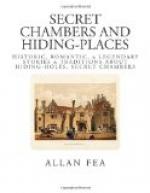Chelvey Court, near Bristol, contained two hiding-places; one, at the top of the house, was formerly entered through a panel, the other (a narrow apartment having a little window, and an iron candle-holder projecting from the wall) through the floor of a cupboard.[1] Both the panel and the trap-door are now done away with, and the tradition of the existence of the secret rooms almost forgotten, though not long since we received a letter from an antiquarian who had seen them thirty years before, and who was actually entertaining the idea of making practical investigations with the aid of a carpenter or mason, to which, as suggested, we were to be a party; the idea, however, was never carried out.
[Footnote 1: See Notes and Queries, September, 1855.]
[Illustration: BIRTSMORTON COURT, WORCESTERSHIRE]
[Illustration: PORCH, CHELVEY COURT, SOMERSETSHIRE]
Granchester Manor House, Cambridgeshire, until recently possessed three places of concealment. Madingley Hall, in the same neighbourhood, has two, one of them entered from a bedroom on the first floor, has a space in the thickness of the wall high enough for a man to stand upright in it. The manor house of Woodcote, Hants, also possessed two, which were each capable of holding from fifteen to twenty men, but these repositories are now opened out into passages. One was situated behind a stack of chimneys, and contained an inner hiding-place. The “priests’ quarters” in connection with the hiding-places are still to be seen.
Harborough Hall, Worcestershire, has two “priests’ holes,” one in the wall of the dining-room, the other behind a chimney in an upper room.
The old mansion of the Brudenells, in Northamptonshire, Deene Park, has a large secret chamber at the back of the fireplace in the great hall, sufficiently capacious to hold a score of people. Here also a hidden door in the panelling leads towards a subterranean passage running in the direction of the ruinous hall of Kirby, a mile and a half distant. In a like manner a passage extended from the great hall of Warleigh, an Elizabethan house near Plymouth, to an outlet in a cliff some sixty yards away, at whose base the tidal river flows.
Speke Hall, Lancashire (perhaps the finest specimen extant of the wood-and-plaster style of architecture nicknamed “Magpie “), formerly possessed a long underground communication extending from the house to the shore of the river Mersey; a member of the Norreys family concealed a priest named Richard Brittain here in the year 1586, who, by this means, effected his escape by boat.




